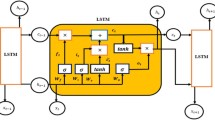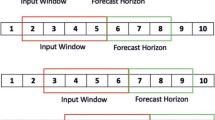Abstract
To predict Solar Cycle 25, we used the values of sunspot number (SSN), which have been measured regularly from 1749 to the present. In this study, we converted the SSN dataset, which consists of SSNs between 1749 – 2018, into a time series, and made the ten-year forecast with the help of deep-learning (DL) algorithms. Our results show that algorithms such as long-short-term memory (LSTM) and neural network autoregression (NNAR), which are DL algorithms, perform better than many algorithms such as ARIMA, Naive, Seasonal Naive, Mean and Drift, which are expressed as classical algorithms in a large time-series estimation process. Using the R programming language, it was also predicted that the maximum amplitude of Solar Cycle (SC) 25 will be reached between 2022 and 2023.











Similar content being viewed by others
References
Adhikari, R., Agrawal, R.K.: 2013, arXiv .
Aguirre, L.A., Letellier, C., Maquet, J.: 2008, Solar Phys. 249, 103. DOI .
Atici, R.: 2018, Astrophys. Space Sci. 363, 231. DOI .
Attia, A.-F., Ismail, H.A., Basurah, H.M.: 2013, Astrophys. Space Sci. 344, 5. DOI .
Chattopadhyay, G., Chattopadhyay, S.: 2012, Eur. Phys. J. Plus 127, 43. DOI .
Dancho, M.: 2018, blogs.rstudio.com/tensorflow/posts/2018-06-25-sunspots-lstm/ .
Dikpati, M., De Toma, G., Gilman, P.A.: 2006, Geophys. Res. Lett. 33, L05102. DOI .
Gkana, A., Zachilas, L.: 2015, J. Eng. Sci. Technol. Rev. 8, 79.
Hiremath, K.: 2008, Astrophys. Space Sci. 314, 45. DOI .
Javaraiah, J.: 2008, Solar Phys. 252, 419. DOI .
Kane, R.: 2007, Solar Phys. 246, 487. DOI .
Kilcik, A., Anderson, C., Rozelot, J., Ye, H., Sugihara, G., Ozguc, A.: 2009, Astrophys. J. 693, 1173. DOI .
Kim, K.B., Kim, J.H., Chang, H.Y.: 2018, J. Astron. Space Sci. 35, 151.
Layden, A., Fox, P., Howard, J., Sarajedini, A., Schatten, K., Sofia, S.: 1991, Solar Phys. 132, 1. DOI .
Lewis, N.D.: 2016, Deep Time Series Forecasting with Python: An Intuitive Introduction to Deep Learning for Applied Time Series Modeling, Create Space Independent Publishing Platform, New York.
Li, K., Feng, W., Li, F.: 2015, J. Atmos. Solar-Terr. Phys. 135, 72. DOI .
Maleki, A., Nasseri, S., Aminabad, M.S., Hadi, M.: 2018, KSCE J. Civ. Eng. 22, 3233. DOI .
Nielsen, M.L., Kjeldsen, H.: 2011, Solar Phys. 270, 385. DOI .
Okoh, D., Seemala, G., Rabiu, A., Uwamahoro, J., Habarulema, J., Aggarwal, M.: 2018, Space Weather 16, 1424. DOI .
Penn, M.J., Livingston, W.: 2011, In: Choudhary, D.P., Strassmeier, K.G. (eds.) The Physics of Sun and Star Spots, IAU Symp. 273, 126.
Pesnell, W.D.: 2008, Solar Phys. 252, 209. DOI .
Petrovay, K.: 2010, Living Rev. Solar Phys. 7, 6. DOI .
Pishkalo, M.: 2008, Kinemat. Phys. Celest. Bodies 24, 242. DOI .
Pishkalo, M.: 2014, Solar Phys. 289, 1815. DOI .
Quassim, M.S., Attia, A.-F., Elminir, H.K.: 2007, Solar Phys. 243, 253. DOI .
Raissi, M., Karniadakis, G.E.: 2018, J. Comput. Phys. 357, 125. DOI .
Rigozo, N., Echer, M.S., Evangelista, H., Nordemann, D., Echer, E.: 2011, J. Atmos. Solar-Terr. Phys. 73, 1294. DOI .
Sabarinath, A., Anilkumar, A.: 2018, J. Earth Syst. Sci. 127, 84. DOI .
Sagir, S., Atici, R., Ozcan, O.: 2018, Pramāna 91, 54. DOI .
Sagir, S., Yesil, A.: 2018, Wirel. Pers. Commun. 102, 31. DOI .
Sagir, S., Karatay, S., Atici, R., Yesil, A., Ozcan, O.: 2015, Adv. Space Res. 55, 106. DOI .
Sarp, V., Kilcik, A., Yurchyshyn, V., Rozelot, J., Ozguc, A.: 2018, Mon. Not. Roy. Astron. Soc. 481, 2981. DOI .
Sena, D., Nagwani, N.K.: 2016, J. Eng. Appl. Sci. 11, 13123.
Shaikh, Y.H., Khan, A., Iqbal, M., Behere, S., Bagare, S.: 2008, Fractals 16, 259. DOI .
Shumway, R.H., Stoffer, D.S.: 2011, Time Series Analysis and Its Applications: With R Examples, Springer, Berlin, 47.
Siami-Namini, S., Namin, A.S.: 2018, arXiv .
Sirignano, J., Spiliopoulos, K.: 2018, J. Comput. Phys. 375, 1339. DOI .
Thompson, R.: 1993, Solar Phys. 148, 383. DOI .
Zazo, R., Lozano-Diez, A., Gonzalez-Dominguez, J., Toledano, D.T., Gonzalez-Rodriguez, J.: 2016, PLoS ONE 11, e0146917. DOI .
Author information
Authors and Affiliations
Corresponding author
Ethics declarations
Disclosure of Potential Conflicts of Interest
The authors declare that they have no conflicts of interest.
Additional information
Publisher’s Note
Springer Nature remains neutral with regard to jurisdictional claims in published maps and institutional affiliations.
Rights and permissions
About this article
Cite this article
Pala, Z., Atici, R. Forecasting Sunspot Time Series Using Deep Learning Methods. Sol Phys 294, 50 (2019). https://doi.org/10.1007/s11207-019-1434-6
Received:
Accepted:
Published:
DOI: https://doi.org/10.1007/s11207-019-1434-6




